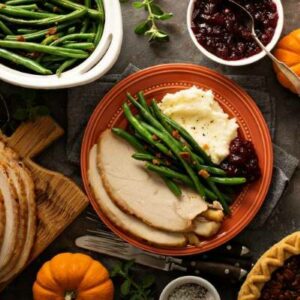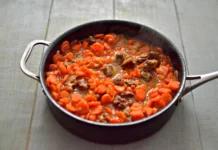
One November when I was growing up, cranberries must have been on sale because my mother bought twice what she needed. The following year, there was a cranberry blight, causing the tart berry to be unavailable.
Needless to say, our Thanksgiving guests were shocked when they saw cranberry sauce on our table. But they were even more astounded when they heard that those cranberries were in the freezer for a solid year — solidly encased in ice.
No one froze food more prolifically than my mother. Most of it was forgotten, until she’d pull a pathetic specimen from the freezer, shriveled at the edges and dotted with white crystals. Undaunted by its appearance, she served it anyway. For this reason, I’ve never been a fan of freezing food.
So, I was surprised when a friend said she prepares her entire Thanksgiving dinner and freezes everything in the weeks before the holiday. This sounded so bizarre that it outdid anything my mother dreamed up. While my friend swore everything tasted delicious — even pies — I didn’t believe her.
Out of curiosity, I consulted the foodsafety.gov website and learned that cooked food lasts in the freezer between two to six months before deteriorating. Since then, I’ve experimented with short-term freezing and defrosting of turkey, cranberry sauce, stuffing and vegetable casseroles. Surprisingly, the results were fantastic.
This is really good news for people like me who can only fit prepping one dish a day into their busy lives, or who are driving distances to their Thanksgiving celebration and bringing most of their feast with them.
Here are some food-freezing tips: Wrap every dish as airtight as possible for maximum freshness. Attach a date label so foods don’t linger past their prime. Defrost foods in the refrigerator, rather than on the counter, where they get soggy.
Now that I’ve discovered my freezer’s potential, I’m far more relaxed on Thanksgiving. I have time to chat with family and friends and even catch a little football because the cooking is behind me before the day begins.
Roasted Turkey Breasts | Meat
Each turkey breast serves 4, or 8 servings in all
Equipment: 1 large roasting pan and rack and meat thermometer
Nonstick vegetable cooking spray
2 turkey breasts, approximately the same weight
Kosher salt to taste
⅛ teaspoon, plus ⅛ teaspoon garlic powder, thyme and paprika
Preheat your oven to 375 degrees F. Generously coat the roasting pan and rack with nonstick cooking spray.
Rinse each turkey breast under cold water. Pat them dry with paper towels.
On the bottom of each turkey breast (the bony side), evenly sprinkle salt and ⅛ teaspoon each of garlic powder, thyme and paprika.
Place the turkey breasts skin side up on the oven rack. Evenly sprinkle the salt and ⅛ teaspoon of the three spices onto the skin. Insert a meat thermometer into the thickest part of one breast, avoiding bones. Follow your thermometer’s instructions.
Place the turkey breasts in the oven, skin side up. After 30 minutes, turn over the turkeys. Roast for 30 more minutes. (If the meat thermometer is too bulky, remove and replace it until you turn the breast again.) Return the turkey breasts to the oven, skin side up. Continue roasting until the thermometer reaches 180 degrees F., and the turkey juices run clear when a knife is inserted into the thickest part of the breast, about 20 minutes a pound. Wait five minutes before slicing and serving.
To freeze, bring the turkey breasts to room temperature. Do not slice them. Wrap them tightly in aluminum foil; place the wrapped turkeys in plastic bags and seal. Freeze for up to 2 weeks.
Defrost the turkeys for 2-3 days in the refrigerator. Warm them in a 300-degree oven until just heated through. They don’t need to be piping hot. Don’t leave them in the oven too long or the turkeys will dry. Slice and serve.
A Festive Cranberry Sauce | Pareve
Serves 8
¾ cup water
1¼ cups granulated sugar
12-ounce package fresh cranberries
½ cup chopped walnuts
½ cup golden raisins
Place the water and sugar in a large pot. Heat it on a low flame, stirring until the sugar dissolves. Add the cranberries. Raise the flame to medium and bring it to a boil. Reduce the heat to medium-low. Simmer until the cranberries pop open, about 10-15 minutes. Remove it from the flame and add walnuts and raisins. Stir to incorporate.
Cool it to room temperature and spoon it into a container approximately the same volume as the cranberry sauce. Cover and refrigerate until serving or freeze the sauce.
Defrost it in the refrigerator for 3 days. Stir the cranberry sauce before serving.
Homemade Stuffing | Pareve or Meat
Yield: 3½ cups
1½ pounds peasant, Tuscan, sourdough or any good quality crusted bread. (It can be gathered from leftovers in the freeze; the mixing of different breads is encouraged.)
2 tablespoons olive oil, or more, if needed
1 large onion, diced
4 cloves of garlic, minced
8 stalks of celery, diced
½ pound of mushrooms, ideally pre-sliced
1 Granny Smith apple, peeled, cored, and diced
Kosher salt to taste
White pepper to taste
½ teaspoon each: dried basil, dried thyme, dried crushed rosemary needles and dried sage
5 cups chicken or vegetable broth
Nonstick spray
Cut the bread into cubes. This can be done 3 days in advance or further ahead and frozen. Defrost the cubes before making stuffing. Reserve.
Heat the oil on a medium flame in an extra-large pot. Sauté the onion and garlic, stirring until softened, about 2 minutes. Add the celery, mushrooms and apple and stir.
Sprinkle in salt cautiously as broth is often salty. Add the white pepper, basil, thyme, rosemary and sage. Mix until combined. Stir occasionally until the celery and mushrooms are wilted.
Reduce the flame to low. Spoon in the bread cubes and mix until combined. Slowly drizzle in the broth, stopping to stir the mixture several times as you go. Incorporate enough broth to moisten the bread cubes — and no more. Check the salt and add more, if desired. The stuffing should hold together nicely but not be so saturated that it is loose and soaking wet. If there’s leftover broth, use it for another purpose.
Cover the pot and let the stuffing cool to room temperature. Coat a casserole with nonstick spray. Place the stuffing inside the casserole. If serving immediately, heat the stuffing to 350 degrees F.
To freeze, wrap the casserole tightly with aluminum foil and place it in the freezer. Defrost it in the refrigerator for 2-3 days before consuming. When fully defrosted, heat the stuffing at 350 F until a thin crust forms on the top and the stuffing bubbles at the edges, about 20 minutes. Serve immediately.






